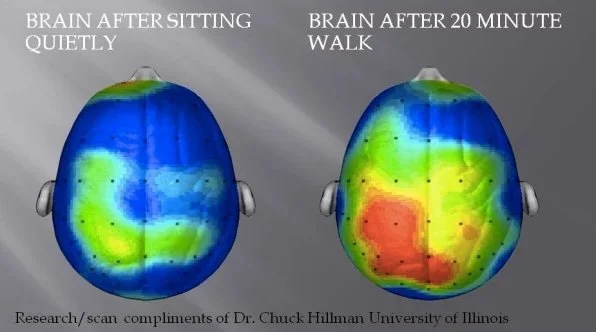How movement influences creativity
“All creative activity begins with movement.” —Joseph C. Zinker
We all know exercise is good for us. It can stave off depression, improve memory, help you maintain a healthy body weight, boost the quality of your sleep, and best of all, it makes you feel great immediately (thanks, endorphins!). I can’t start my day without some kind of movement—whether that’s yoga, a workout video, or a simple walk around the block. Besides doing it for the obvious health benefits, I often work through creative challenges on jogs and have gotten story ideas while in motion.
Creatives have been using the power of movement for decades, or more accurately, centuries. From Aristotle and Virginia Woolf, to Steve Jobs and J.K. Rowling, creatives have known the power of moving to help elicit new ideas, even if they weren’t aware of why it helped them. Jobs was known for his walking meetings, and believed his most creative ideas came while walking. Woolf’s 1927 essay “Street Haunting,” describes the joys of nighttime walking to escape the self, an idea which Alejandro Chacoff expands on in a New Yorker piece, connecting this idea of the power of physical to mental wandering.
Author Anne Lamott leaves index cards in places throughout her home, so she can draft ideas and even novels on these tiny cards, allowing her to capture ideas while moving about her life.
For creatives, movement is a superpower—I promise it’s better than a stiff drink, cigarette, or (dare, I say it) caffeine. There’s more than just anecdotal experiences to back this up. When we’re moving we experience significantly more brain activity than when we’re sedentary. Below is a brain scan taken from a 2009 study out of the University of Illinois:
Recent research also confirms this with walking specifically helping to reshape the white matter in our brain, which is directly connected to memory and our ability to think. Before the 1990s the consensus from scientists was that the brain wasn’t malleable, but thankfully they’ve successfully squashed that theory and now have evidence to show the brain can rewire itself in a process called neuroplasticity. With exercise enhancing the brain’s ability to change, it’s no surprise that it’s also directly connected to creative ideas, with a 2020 study published in Scientific Reports, confirming this (although research still doesn't totally understand the mechanisms of why).
Another interesting study that looked at the connection between walking and creativity is one that came out of Stanford University, in which college students were put through different tests so the researchers could measure how walking impacted creativity. For example, one of the tests had the students think of an analogy, then come up with a unique but more creative option. Those who did this while walking had a 95% success rate, and those who never stood up only were 50% successful.
Does this mean a brisk walk will lead you to genius ideas? Yes and no. The benefits appear to start at 8-minutes, with other studies showing additional benefits (like happiness) happen during a 20- to 30-minute walk. Walking without any distractions, will enhance the creative benefits, since mental chatter prevents your brain from making those unexpected connections. I’ve done both, and find either music that I’m not focusing on or silence to be the best at helping me achieve creative ideas.
There’s also research that suggests being in nature enhances creativity. Berkeley University interviewed David Strayer, a professor from the University of Utah, who believes that nature restores depleted attention circuits, which can open people up to creativity and problem-solving.
One of my antidotes to writer’s block is to talk a nice long, silent walk in nature. You don’t have to be “blocked” to get benefits either. Sometimes, when I’m working out how to proceed with a scene or if I’m thinking about a few ideas but aren’t sure which one to pick, I almost always get those “a-ha” moments while moving. The best part is, it’s free to do and is available to almost everyone. So the next time you’re feeling blah, uninspired, or completely stuck, put those ideas in motion.

